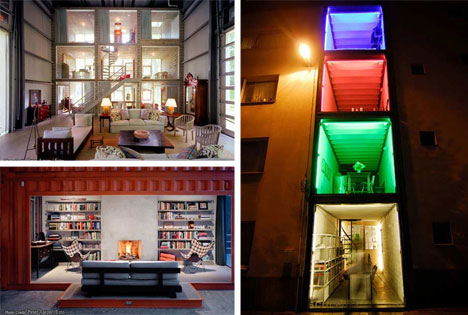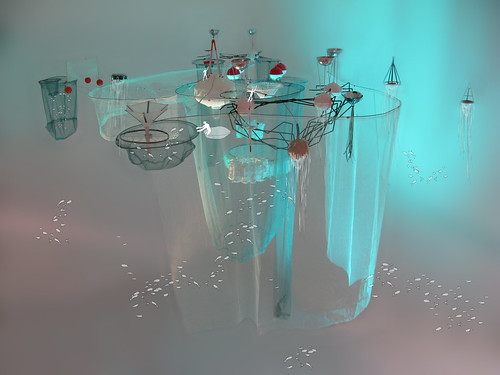An estimated 100 million people around the world are homeless while almost 900 million are living in slums -- a number that will reach 1.5 billion by 2020. Here are some of the innovative solutions to help shelter our neighbors.
Thursday, May 26, 2011
Shopping Cart Homes
I did an ethnography on shopping carts, and came across several concepts using shopping cart-like structures to double as housing options for homeless. This pictures is a rudimentary design of turning shopping carts (a common commodity utilized by homeless in the US) into a sleeping area as well. What is great about this idea is the easy transition from individuals who already use shopping carts to using this shopping cart that at least has somewhere to sleep in a covered area off the ground.
Taking this idea from concept to usable product, EDAR (short for "Everyone Deserves a Roof) is a type of these structures found in LA -- the area of the US with the most homeless people. Here is a video featured on CBS. The creator of the EDAR, Peter Samuelson, was born in Britain. In an interview with LA Times he states, "America is not just a land of opportunity but also of personal responsibility. There's an obligation to lift up society." From their website you can donate money and find ways to become involved.
Wednesday, May 25, 2011
Self-Contained Living

As the green movement sweeps the world, one of the current trends is to turn old, empty shipping containers into liveable space. Whether for offices or homes. The average empty container is $900. They are stackable, moveable, and sturdy. As far as instant temporary housing goes, they aren't a bad option.
These are not feasible for living if you were to stack 10 up, stick a ladder against them, and let disaster victims or such climb up. Ventilation and light, etc would optimally be added, which would raise the cost. In spite of this, two thumbs up for innovation and design for recycling old and using less wood.
The website from which the picture comes is an excellent read if you are interested in creating your own shipping container home.
Open Sailing

Open Sailing is an ongoing international project for creating the equivalent (use that term loosely) of a space station in the ocean. Perhaps someday houses and even cities would be able to exist, allowing humans to live in the middle of the ocean.
Involved in the plans are nomadic farming structures and a very interesting central cable that incorporates all life-sustaining necessities into one cord.
Sand Dune to Structures

Magnus Larsson, a complete genius, has discovered a way to construct buildings out of sand. While I believe he has explained himself best in the 15-minute video on Ted, I will provide an even briefer synopsis for those who only have 13 minutes.
Larsson proposes to use Bacillus pasteurii, a bacteria found in wetlands, as a natural cement to bind sand together, transforming the shifting sands of time to be immovable. Besides reducing desertification, this also provides a means to produce sand structures more suitable for kings and commoners alike than the little castles lining tourist beaches around the world.
To make structures or a giant wall in Africa (either one), balloons would be filled with the bacteria and placed in the way of moving dunes and then popped after the blowing sands covered them.
Some concerns from the public include the repercussions of removing substantial amounts of the bacteria from the wetlands, the sand would merely blow over or around the wall, and the sand may merely blow back to other unwanted and possibly inhabited areas.
Larsson admits there are many problems that need to be solved before this solution would be put in effect. I think even if the giant wall doesn't work, using the bacteria for housing structures is an excellent idea since it requires minimal water to construct buildings out of existing materials in harsh environments that probably do not have trees, etc.
Micro Home Solutions

A recent Harvard grad (I don't mean to put immediate generalizations in your mind by starting this post with that phrase), Rakhi Mehra is the tip-off I received for this innovation. She is a co-founder of a for-profit company called mHS, or micro Home Solutions.
Micro Home Solutions is designed to "provide hi-design-low-cost home solutions to the urban poor on their own terms" (quote taken from website). The project is beginning in India in New Delhi, but has dreams of expanding. I hope they do.
Their current projects include Design Home Solution (technical assistance/finance to low income households), urban housing, eco tourism (partnered with Due North), and a modular shelter project for temporary and permanent shelter for the homeless and harsh weather conditions.
The idea of involving individuals in the process of housing projects is immensely appealing to the social scientist wthin me. Cookie-cutter housing projects attempting to update slums and poor areas are socially catastrophic in several ways as it does not remove previous stigma or give the individuals living there a sense of pride or ownership. Micro Home Solutions works to provide shelter for all, but not necessarily for free. This is phenomenal.
Concrete Canvas

A friend sent me the link to this video showing a structure made with cement cloth (sounds weird, right?) that hardens after being inflated and then saturated with water.
Concrete Canvas is a UK company who designed this cloth for durable structures needing nothing more than water and air. Don't worry, this structure is waterproof after it "cures" and is strong enough to pile soil or snow all the way around it.
Here is a very recent piece BBC did (and, in my opinion the best video) for the CCS (Concrete Canvas Structures).
The most obvious problem with this construction effort is the weight of the structure for transporting it. It requires a forklift to move the initial, folded structure. However, the weight provides a durability lasting, as the video claims, up to 10 years. Seems to be worth the trade off if you need massive, permanent, instant and sterile structures in a specific location. As mentioned, the buildings are being utilized in military operations to protect troops and also in relief efforts, such as post-tsunami Japan.
Another issue is the availability of water in some areas of the world. Luckily one may use salt water to construct the building; however, areas with little and continuously decreasing water supplies (such as the Middle East) may have some issues setting up more than one or two of these structures should relief aid call for it.
The company's photo gallery offers pictures of the structures and the other uses Concrete Canvas is discovering. The cloth is now being used as ditch liners, slope covers (to prevent landslides, etc). The cloth is also being used in more creative ways, such as armchairs.
Concrete Canvas has won multiple major awards for their innovation, beginning in 2005 and continuing on to 2011, so do not be chary of the aged youtube video you will most likely come across. These structures are still, quite literally, going strong.
Subscribe to:
Comments (Atom)
